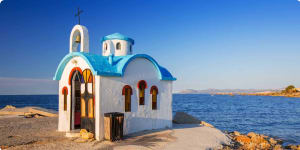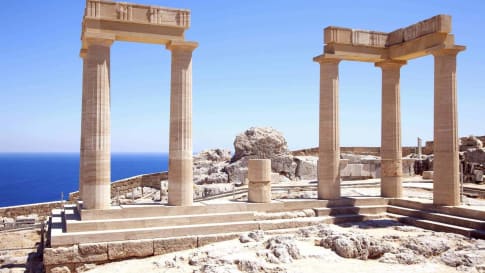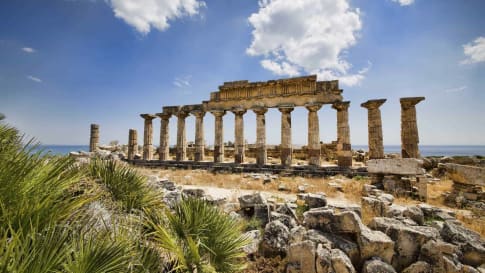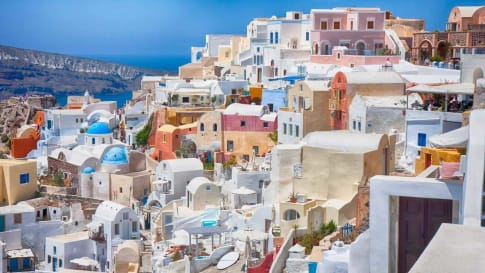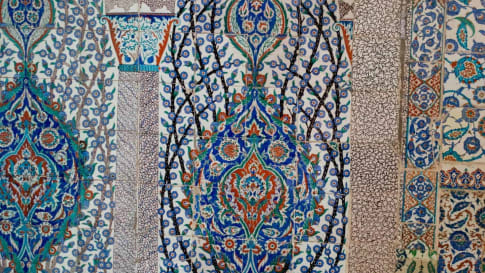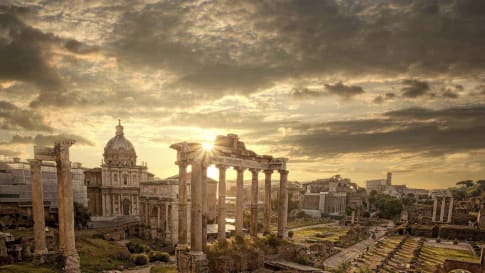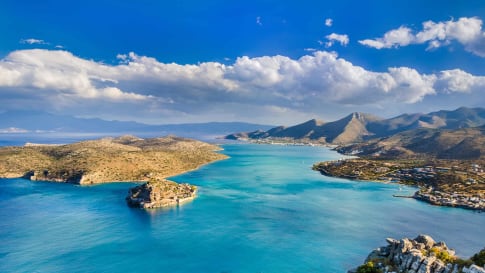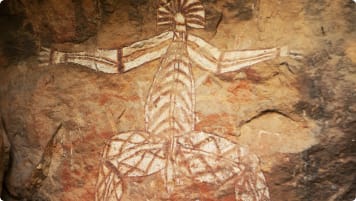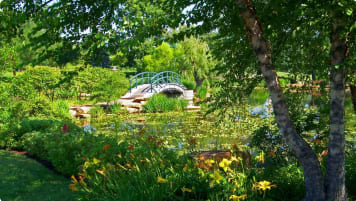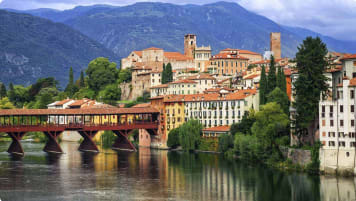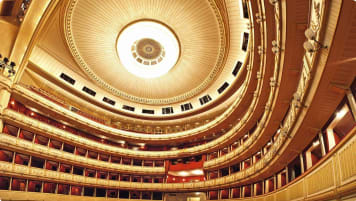Crete Small Group Tour: The Minoans
Crete rich in UNESCO World heritage sites this small group escorted tour provides a travel experience for guests with experienced local guides to remember. For senior couples or single travellers who seek to travel with other like minded people to destinations rich in ancient history then this in one of many small group journeys to be enjoyed.
From A$13,500AUD
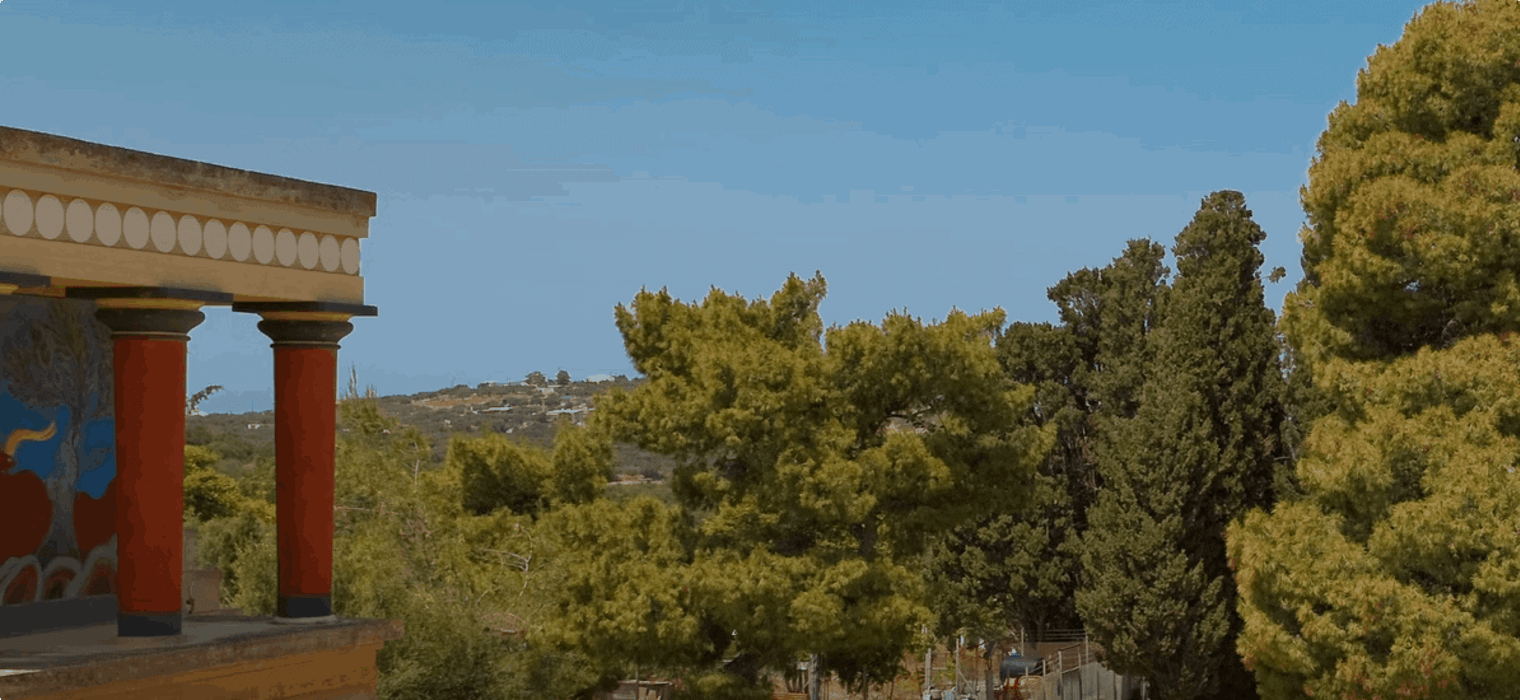
Highlights
- 1. Travel with an Archaeologist and specialist guides for the entire program
- 2. Spend time on the island of Spinalonga with the Venetian fort
- 3. Visit the birthplace of Helena of Troy
- 4. See Cretan history, from Neolithic (c.7,000BC) to late Roman in the field

Departure Dates
| Departure Date | Price |
|---|---|
| 13 April 2025 Ends 02 May 2025 • 20 days A$13,500 Twin A$15,395 Single Available | Selected |
| 21 September 2025 Ends 10 October 2025 • 20 days A$13,500 Twin A$15,395 Single Available | |
| 13 April 2026 Ends 02 May 2026 • 20 days A$13,500 Twin A$15,395 Single Available | |
| 20 September 2026 Ends 09 October 2026 • 20 days A$13,500 Twin A$15,395 Single Available |
Crete Small Group Tour | Learning about the Minoans
This escorted small group tour of Crete is designed around an innovative itinerary that traces the remnants of Minoanculture across the beautiful Mediterranean island. Combining education, a variety of local experiences with a touch of exploration and breathtaking scenery, the magnificent art, architecture and lifestyle of an ancient people long since vanished can be brought to life once again. We will discuss what may have brought about the demise of such a civilisation some 3,500 years ago as this escorted small group tour of Crete takes you to the ancient cities, settlements, and palaces of the Minoans.
Crete is largest of the Greek islands
Situated just over 600 kilometres to the northwest of the great Egyptian city of Alexandria, Crete is the southernmost and the largest Greek island. For thousands of years, the well-positioned and well-provisioned isle has been the focus of the ambitions of those wishing to control the land.
The ancient Cretans are now referred to by archaeologists as the “ Minoans ”, after the labyrinthine nature of the Bronze Age archaeological site unearthed in Crete, and which was probably the origin of the ancient tale of King Minos and the Minotaur.
Knossos was the capital of Minoan Crete, inhabited for several thousand years until its destruction in 1375 BC, which marked the end of Minoan civilization. The palace of Knossos was built circa 1900 BC on the ruins of previous settlements. It was destroyed for the first time along with the other Protopalatial palaces around Crete in 1700 BC, probably by a large earthquake or foreign invaders. It was immediately rebuilt into an even more elaborate complex, and until its abandonment was damaged several times during earthquakes, invasions, and, in 1450 BC, by the colossal volcanic eruption on Thera (Santorini). A British archaeologist excavated the site in 1900 AD and restored large parts of the palace.
Minoans have been described as the manufacturers of the first luxury goods
Archaeological site work, that we will witness in the archaeological museum, has revealed evidence, dating to the third millennium BC, of a thriving trade network centred on Crete that dealt in tin and copper, the constituent elements for bronze. It is likely that this particular commodity brought great wealth and prosperity to Minoans as they raised their great palaces and expanded their settlements across the entire island. As affluence increased so did trade in other goods, with archaeological site excavations in the ancient ruins by archaeologists pointing to the import of items such as jewellery, wine and luxury foodstuffs. In exchange, the Minoans maintained an established export of ceramics, timber from their cypress forests and even textiles, although the latter leave little trace from so long ago.
On this guided tour, you will be on Crete, the once vibrant hub of a cultural and trade network that radiated out from a thriving Minoan civilisation to influence communities spread around the Mediterranean. There were strong connections with Egypt, the Levant and with mainland Greece. There is also the strong likelihood that the Minoan sphere of trading influence extended westwards to Sicily and Italy.
The life of the Minoans at home revolved around an agricultural lifestyle and their diet was likely much the same as many of the modern people of Crete today. Seafood, vegetables, grains and dairy, supplemented by the ever-present olive and its delicious and functional oilproduced from the local olive grove would have been found on the tables of most households. Wine appears to have been plentiful and the Minoans also enjoyed barley beer. Their houses were comfortable, built from local stone, topped with mud-brick and wood.
Minoan civilisation declined and disappeared some time during the 15 th century BC. Certain scholars point to the eruption of the volcano on nearby Thera, hypothesising that this devastated the cities of the Minoan trading allies thus causing their economy to collapse. Others believe there was an invasion from outside of the island taking over a government possibly riven by internal problems. It remains conjecture as to what actually happened but the influence and the legacy of this great people lives on.
Crete Small Group Tour Itinerary
On this 21-day trip designed for seniors and mature-aged travellers, we will go on wonderful excursions on the Aegean Sea as we wander the palace precincts of Knossos, Malia, Zakros and Galatas. We will consider the influences, the political organisation and the society that provided for such impressive structure and adornment. This escorted small group tour of Crete provides an itinerary the explores east and western Crete. Stroll along the streets of the old townsettlements of Phaistos, Tylissos or Agia Triada and let your imagination take you where it will, as the paved streets and water systems stretch from one side of the town to the other. Marvel at the view from every home and shop across the island settlement of Pseira and think about explanations for its seemingly isolated position. Travel out over the now sunken causeway to Minoan Mochlos and wile away hours exploring its stone-lined streets and alleys. Revel for a time in the legend of Zeus as you look in awe upon the interior of the Dikteon Cave, and view first hand the later Venetian influences around the old harbour precincts of Chania and Heraklion.
This small group tour learning about the Minoans on Crete is bound together by the thread of the Minoans, but we will also be able to learn more about contemporary Cretan life. You will sample Cretan culinary delights made with many of the same ingredients that the Minoans used, and look on while oil and wine is produced by ancient methods before you. You will sail on the blue waters of the Aegean over shipwrecks from across the millennia, but be back in time for dinner and wine tasting at a harbour-side local restaurant surrounding the small ports, or perhaps at a taverna in a local village.
The Crete small group tour is for 21 days staying at 6 different locations. As a small group, you explore and visit 26 different destinations with a tour director (program leader), national and local guides, who share their knowledge about the Minoans with you. The itinerary also gives you time to relax and explore the island on your own.
You can learn more about Greece by reading our country profile. We also publish articles to assist senior travellers with their preparations, such as about the history of Crete history and the history of Santorini , frequently asked question about Greece , Greek civilisation , and the history of Athens . as well as related articles:
This external website is also a useful reference;
Gallery
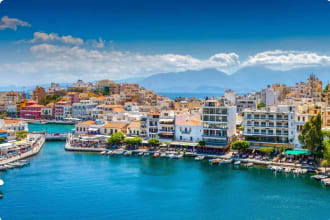
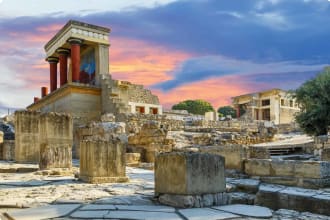
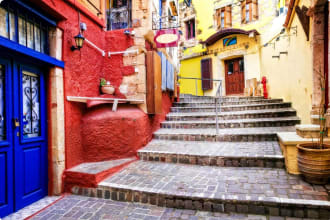
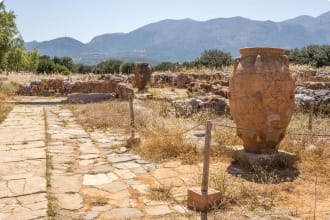
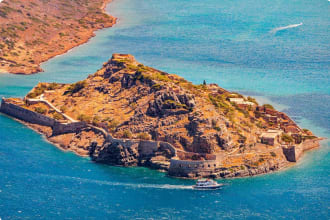
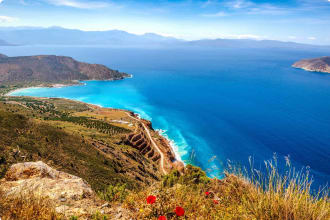
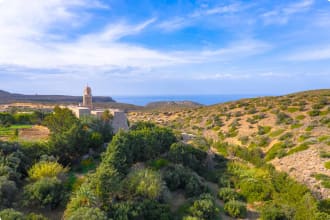
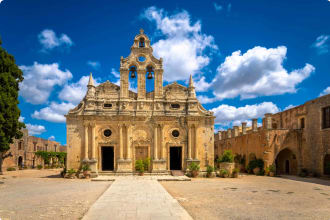
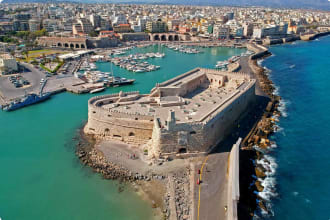
Itinerary
20 days
Day 1: Heraklion
Accommodation: Overnight Ibis Styles Heraklion centre or similar
Today, this escorted small group tour of Crete meet the tour director (program leader) for introductions and enjoy a welcome dinner locally.
Day 2: Heraklion
Accommodation: Overnight Ibis Styles Heraklion centre or similar
Today we commence the program with a walking tour of Heraklion and its place in the history and settlement of Crete. Your tour guide leads you on a visit to the Archaeological Museum. The Heraklion museum has antiquities that span several thousands of years, Minoan, post-Minoan and later periods that we will take some time to view and discuss.
During our walk we visit the Morosini Lions Fountain, Dermatas Gate, the cathedral of Saint Minas and from the Venetian period, the Fort, the city walls and shipyards and the Venetian harbour.
Day 3: Heraklion
Accommodation: Overnight Ibis Styles Heraklion centre or similar
Today on our day trip, we travel out to visit the ancient archaeological site of Knossos to explore further our understanding of Minoan civilisation. This afternoon we take a trip to the town of Tylissos for a guided tour.
This evening there is a group meal.
Day 4: Heraklion
Accommodation: Overnight Ibis Styles Heraklion centre or similar
Today is a break day on the itinerary. If you’d like, you can simply rest up. Or you’ll have the opportunity to further explore Knossos palace or the ancient city of Heraklion. Your Tour Director will also be offering a time to meet for an activity or evening meal.
Day 5: Agios Nikolaos
Accommodation: Overnight Avra Collection Hermes Hotel or similar
Today we travel some 30km to Agios Nikolaos. We visit and learn about the Minoan civilisation at Galatas and Malia, exploring the ancient ruins and the archeological site at both locations as our tour guide provides the narrative.
Tonight there is a group evening meal in Agios Nikolaos. This group has a chance to enjoy the culinary delights of Crete al-fresco.
Day 6: Agios Nikolaos
Accommodation: Overnight Avra Collection Hermes Hotel or similar
Today we take the boat out to explore the island of Spinalonga and the Venetian fortifications for the day. We enjoy a barbecue lunch and a walking tour of the island, before returning in the late afternoon.
Day 7: Agios Nikolaos
Accommodation: Overnight Avra Collection Hermes Hotel or similar
Today the itinerary has this small group take a day trip from Agios Nikolaos to explore Gournia Minoan Town as well as Mochlos city with our local tour guide.
Day 8: Sitia
Accommodation: Overnight Sitia Beach or similar
From Agiuos Nikolaos this escorted small group tour of Crete will travel on to the old town of Sitia. On our way we pause and take the ferry to Pseira island.
On the island with our local tour guide we have a walking tour to the key archeaological site where we explore and learn more about the Minoan culture through the preserved ancient ruins on the island.
Pseira began life as a small settlement as early as the Final Neolithic period and continued to grow throughout the Minoanperiod, reaching its highpoint during the Late Minoan when the Minoan palaces were also at their height.
Today, Pseira is a small uninhabited island, a couple of kilometres off the coast of Crete and a stone’s throw away from another Minoan centre at Mochlos. A small peninsula on the south side of the island provided the Minoans with a harbour — basically little more than a small beach — protected from the north winds. The town grew up on both sides of the harbour, but the peninsula is the area where most buildings are to be found — indeed they extend along its whole length. The ancient ruins on this island provide on this walking tour an intriguing insight into Minoan civilisation supported by the commentary and observations from the local tour guide.
We carry on to Sitia. Here the tour director and tour guide explain about the Venetian harbour overlooked by Kazarma Fortress which was also built by the Venetians and sacked by the Turks. There will also be a visit to the Archaeological museum of Sitia to view the collection of Minoan civilisation finds from Sitia, Zakros, Petra and Palaikastro to add to our knowledge of the Minoan.
There is a group meal tonight.
Day 9: Sitia
Accommodation: Overnight Sitia Beach or similar
Today we continue our study, visiting the Zakros Minoan Palace, the Palaikastro settlement, and the Kazarma Fortress in Sitia.
The Palace was surrounded by the town, of which only a part has so far been excavated. The houses were often quite large, containing up to 30 rooms, with small storage rooms built around a large room with a bench and a central support. The houses were arranged in blocks and both olive oil and wine presses were found in the town. It seems that the town specialised in the production of wine which was exported to the Cyclades. It is almost certain that some of the town buildings were not houses, however, but buildings belonging to the palace.
The Palace was surrounded by the town, of which only a part of the archaeological site has been excavated. Minoanhouses were often quite large, containing up to 30 rooms, with small storage rooms built around a large room with a bench and a central support. The houses were arranged in blocks and both olive oil and wine presses were found in the town. It seems that the town specialised in the production of wine which was exported to the Cyclades.
The Palace of Zakros probably acted as the Minoan gateway to the east Mediterranean sea and this view is supported by various finds on the site which had come from the Middle East. For example In the West Wing of the palace the ancient ruins have yielded an elephant tusk and six ox-hide ingots were found and Cananite jars were discovered near the well.
Like the other palaces, Zakros was rebuilt after the earthquake destruction of the old palaces. The second palace was built around 1600 BCE and finally destroyed around 1450 BCE, along with other centres of Minoan civilisation in Crete. Fortunately many artefacts were left in situ, probably due to the suddenness of the destruction. The palace covered 8,000 square metres, contained 150 rooms and had a Central Court measuring about 30 metres by 12 metres, considerably smaller than that of Knossos.
Palaikastro, which grew to be the second largest town in Crete after Knossos, its layout seems to have been largely planned by a central authority. The town is arranged in blocks. A main street ran for a length of 145 metres through the town and three very narrow streets ran off the main street at right angles, one of them for a length of 70 metres. More than half the width of the main street was taken up by a raised pavement.
Each block consists of four or five houses, one of which tends to be larger than the others and contains more significant architectural features, for example, a facade of ashlar masonry. In particular, the largest house in several of the blocks contained what has been named a Palaikastro Hall, a room with a sunken area in the centre surrounded by four pillars. Of the four Palaikastro Halls identified, three had a lustral basin at close proximity. It has been suggested that each block may have been occupied by people related to each other, either an extended family or members of a clan.
It is assumed, given the location of the town, that the main economic activities of the inhabitants would have been agriculture and trade. But these two basic strands of the local economy also supported a wide variety of craft activities. Weaving was a major activity throughout the town as shown by the number of loomweights found all over the site. The manufacture of products in metal, stone and ivory, for which the raw materials would have been imported, provided the elite families with high status goods made from rare materials. The houses of these families were in some cases decorated with wall paintings, although only fragments have been found. Finally the production of pottery, both for consumption in the town and for export to other areas of Eastern Crete would have been a major activity. A potter’s kiln has been excavated but it can’t have been the only one, and potter’s wheels have also been uncovered.
Evidence of cult activity was found throughout the site and on a scale not found elsewhere. Among the finds of a religious or cult nature were incense burners, rhyta, triton shells, large stone baetyls, horns of consecration and double axes. However the most important cult find was a carving in ivory of a young male believed by excavators to be a Minoanforerunner of the Diktaian Zeus. The ivory figure had been deliberately broken either by disillusioned worshippers or by the Mycenaeans when they arrived in the town.
A number of cemeteries were discovered by the original excavators and these circle the Minoan town. In Early MinoanCrete communal burials were practised with the bones of the deceased buried with their grave goods in a secondary burial after the body had fully decomposed. In central south Crete burials were in tholos tombs, but in north and east Cretehouse tombs were constructed. It is thought that the house tombs at Palaikastro contained two areas, one open area in which the body decomposed before the bones were collected and placed in the second, smaller area, an ossuary, together with the grave goods. In Late Minoan Crete after the arrival of the Mycenaeans, there was a move towards individual burials in larnakes, a number of which were found in the cemeteries of Palaikastro.
The group returns to Sitia from this day trip to visit the Kazarma Fortress. The remainder of the day for this escorted tour group is at your leisure.
The remainder of the day is at your leisure.
Day 10: Rethymno
Accommodation: Overnight Ionia Suites or similar - apartment
Today we transfer to Rethymno. We visit the Dikteon Cave & Zeus Cave. This is the legendary birthplace of Zeus!
There is a group dinner in the evening.
Day 11: Rethymno
Accommodation: Overnight Ionia Suites or similar - apartment
On our first full day tour based in Rethymno, as a small group we visit the Agia Triada archaeological site, the archaeological site of Phaistos, Kommos and the Monastiraki Minoan Palace.
The first visit on todays trip is to the Palace of Phaistos.
With the Messara plain to the east and the Ida mountain to the north, Phaistos has the most beautiful setting of any of the Minoan Palaces.
This Palace like all the other palaces except for Zakros, is oriented north-south. It is commonly accepted that the main entrance to the New Palace was from the West Court, up the dozen steps of the 14 metre wide Magnificent Staircase, at the top of which is an equally wide landing, behind which stood the Monumental Propylaia. This structure is the forerunner of the Propylaia of Classical Greek times. The palace the group will learn as evidenced by the ancient ruinsseen, underwent several periods of re-building
Phaistos does not get quite so crowded as Knossos it is possible to have the site almost to oneself provided one arrives at opening time or alternatively an hour or two before closing time. And for a small group tour this is a more intimate site than Knossos where walkways of scaffolding impede the view. At Phaistos, everything can be seen easily and close up.
The Palace of Phaistos lies on the East end of Kastri hill at the end of the Mesara plain in Central Southern Crete. To the north lies Psiloritis, the highest mountain in Crete. On the slopes of Psiloritis is the Kamares cave, probably a religious or cult centre for Phaistos and the Mesara plain. In this cave a very fine pottery style was discovered from the Middle Minoan period, which has been named Kamares Ware after the cave in which it was found. Kamares ware has only been found at Palace sites like Phaistos and Knossos, suggesting that it was specially produced for whatever elite was based in the Palaces.
A couple of kilometres to the west of Phaistos is the important Minoan site of Ayia Triadha. To the south of Phaistos are the Asterousia mountains beyond which lies the Libyan Sea. To the south west is Kommos, the ancient port of Phaistos and to the east, the vast Mesara plain, the single largest fertile area in Crete, which in Minoan times was populated with small settlements with their distinctive tholos tombs.
We then travel to Ayia Triada to view the ancient ruins of the Minoan. This town was probably first settled towards the end of the Neolithic. Agia Triada was inhabited throughout the Middle Minoan period, but it is still not known how important the settlement was at that time. However, there are many unique features seen in this collection of ancient ruinsto allow the group to discuss what may have been with the tour director and tour guide.
Some 5 kilometres south-west of Ayia Triada and six kilometres south-west of Phaistos. The ancient ruins of the Minoansettlement of Kommos is found, on a small hill next to the beach at the end of the Messara plain near the village of Pitsidia. It is most likely that the harbour served the palace of Phaistos. This is borne out by the discovery of a variety of imported pottery discovered on the archaeological site dig. It is possible that Kommos was linked to Phaistos by a paved road. It is also importnat to consider the number of people residing in this area and the tasks allocated to the commuinity for it to flourish.
Monastiraki is our final stop, it is situated on a hill overlooking the Amari Valley, south east of Rethymno and close to the village of Monastiraki, from which it takes its name. The Minoan name of the complex is not known. Monastiraki is one of the most important Middle Minoan archaeological sites in Crete. This is an an extensive archaeological site, with palatial features, but when it was destroyed at the end of MM IIB, it was not rebuilt and so we have a Middle Minoanbuilding complex undisturbed by later levelling and rebuilding making it unique. This site covers some 300,000 m2 and there is evidence of agriculture and animal husbandry being practised as well as the manufacture of wool and cloth. Monastiraki was also a major administrative centre as revealed by the hundreds of sealings found on the site, many linking this complex with the Palace at Phaistos. There remains a lot of work to be done on this site. However, there are no photos permitted to be taken here, enforced by the local residents.
There is a group dinner this evening.
Day 12: Rethymno
Accommodation: Overnight Ionia Suites or similar - apartment
The day is free for individual touring of Rethymno.
Rethymno is located in the north end of the prefecture, built by the sea and is a city with many faces. Rethymno(Rethymnon) or Rithymna as it was once called has been inhabited since the Later Minoan III period. This town of 50,000 people today has worked to preserve much of its Venetian and Turkish heirtage and is regarded as one of the best preserved medieval towns in Greece. Venetian fortification works sit with orthodox and catholic churches, mosques, majestic mansions of Venetian architecture, arches and cobbled paths are found in the old town reflective of the towns turbulent –yet glorious– past.
There are two sides to Rethymno offering two styles of visit: the endless big beach hotel strip that stretches from the east end of Rethymno, lapping up the coastal “villages” of Perivolia, Platanias, Adelianos Kambos, Pigianos Kambos, Sfakaki, Stavromenos and Skaleta – and – the Rethymno that allows you the character of the old town with its mix of architecture and history, cultural influences and styles ranging from Venetian to Ottoman empire. This tour focuses on ther latter leaving the all-inclusive beach and booze tours to others.
The Venetian harbour dominates the old town harbour edge, though is overlooked by the Venetian built Fortress making Rethymno very photogenic. Pedestrian streets below the fortress, strewn with charming old buildings. Venetian influences dominant and the minarets and domed mosques remind the viewer of the Turkish influence long gone in the old town. The doge and the merchants of Venice in this port as well as others visited ensured there where funds available to protect Venice trading interests in this part of the Mediterranean sea.
In the evening we have a group meal at a local organic farm.
Day 13: Chania
Accommodation: Overnight Belmondo Hotel or similar
Today we travel onto Chania. We will take a break in the beautiful village of Stylos.
Stylos may be a beautiful village but there is a unique Minoan archaeological site in a olive grove next to the village. We inspect a dromos and tomb complex, both are well preserved, though looted.
In the afternoon we enjoy a guided walking tour of Chania. Whilst the Minoan civilisation where here, this town of 60,000 people has over time been smothered by the Venetians, the Turks, and the Egyptians over the centuries. And it is there influence that dominates this large coastal town from the Ventian harbour to lighthouse and harbour edge. The merchants of Venice sought to make sure this harbour and the onward passage of goods by sea from the Black sea and Alexandria was secure.
Tonight there is a group meal.
Day 14: Chania
Accommodation: Overnight Belmondo Hotel or similar
Today, we pause to luxuriate in this picture postcard seaside small town. The day in Chania is yours to relax and reflect, explore or just sit, read & watch.
Day 15: Chania
Accommodation: Overnight Belmondo Hotel or similar
Continuing to explore Western Crete, today there is a walking tour along the Imbros gorge for some 7km with a local tour guide. The walk starts near the town of Imbros and finishes at Komitades.
This small group tour is offered this walk because of its significance in the disastrous Second World War Battle of Crete, famous for high casualties, catastrophic military mistakes on both sides, and for the hurried retreat of the British and ANZAC (Australia & New Zealand Army Corps) troops across the Lefka Ori, down this ancient gorge trail. As you walk down this gorge which at times is no wider than 1.6m you cannot help but think about the thousands of ANZAC and British soldiers who had to evacuate through the Imbros Gorge to the ships waiting at Sfakion to take them to safety in Egypt in late May of 1941.
There is free time in Komitades to allow you to explore before returning to Chania.
Komitades was a village of rich merchants (“komites’ means nobleman) who built big houses in the village, but Komitades, like all villages in the 9th century AD, was regularly attacked and destroyed by the Arabs. There is a 14th century church in the village ” Agios Georgios”, with frescoes by the painter Ioannis Pagomenos. This Byzantine church from 1314 is accessible via a path down, which starts at the central square of the village. You follow the path behind the wall of the church downwards and after a few minutes you go left when the wall is interrupted. You keep walking along the wall and then you see the church on your left hand side. The Agios Georgios church was built by the inhabitants of the village in honor of Agios Georgios. During one of the attacks by the Arabs, they prayed to this Saint in order to save the village. After they had been spared, the church was built to thank him.
Near Komitades there is an old monastery, the monastery Panagia Thymiani (400 meter south of the junction Hora Sfakion / Komitades). On May 29 in the year 1821 the revolution against the Turks began in this very monastery.
There is a group meal at a local Taverna this evening.
Day 16: Kissamos
Accommodation: Overnight Gallini Beach Hotel or similar
In the morning we travel around 40 kilometers to Kíssamos.
In Kíssamos after lunch at your leisure, we visit the local museum, located in a fine old building which was once the Venetian, then Ottoman, command-post. The ground floor contains flawlessly labelled finds from nearby ancient Polyrrhenia and Phalasarna. It is primarily pottery amongst a myriad of intriguing exhibits organised by chronology and provenance.
But the museum’s pride and joy lies upstairs: two Roman mosaics from a late second or early third century AD villa. The first juxtaposes the Roman Four Seasons with Three Horae (Dancers) symbolizing the traditional Hellenic tripartite division of the year. The second panel, damaged but still vivid, is devoted to Dionysiac themes.
There is a group dinner this evening.
Day 17: Kissamos
Accommodation: Overnight Gallini Beach Hotel or similar
Today we travel to the ancient city of Falassarna. This Minoan city had a direct maritime link to Alexandria in Egypt a major contributor to its prosperity. However, the local sailors did not limit their activities to peaceful trading; like the inhabitants of other coastal cities of the time, they were also particularly fond of piracy.
This ancient city after an earthquake is now some 100m inland from the coast. To date this archaeological site has ex[posed the remains of walls (including walls of an Acropolis) and towers, a rock carved stone throne can be seen as well as tombs, cisterns, storerooms and the ruins of houses.
What is unique in these ancient ruins is the entrance to the port of Falassarna. This was enclosed by a specially dug channel that connected the harbour to the sea. This harbour was approximately 100 x 75 meters large and it was surrounded by fortified walls and towers. There are also a number of buildings found on an acropolis north of the port. South of the harbour, between the beach and parking lot along the way, you can see the great stone “throne” and on this spot below is a quarry where stones were carved out in order to build up the city. Two cemeteries were found southeast of the fortification walls, of which the larger one extends for approximately 500 meters from the walls. The trading link to Alexandria and Egypt make this an interesting part of the history of Minoan civilisation.
The late afternoon is at your leisure.
Day 18: Heraklion
Accommodation: Overnight Ibis Styles Heraklion centre or similar
Today, we return to Heraklion.
In the afternoon we return to Knossos Palace to refresh our original interpretation of what we saw in this incredible ancient Minoan city, before arriving in Heraklion.
Day 19: Heraklion
Accommodation: Overnight Ibis Styles Heraklion centre or similar
Today, we spend time exploring the role of Crete in WWII with a local guided walk and muesuem visit.
There is a farewell evening meal for the group today.
Day 20: Heraklion
Program finishes after breakfast.
Includes / Excludes
What’s included in our Tour
- 19 nights of accommodation.
- 19 breakfasts, 3 lunches, and 9 dinners.
- Services of Tour Leader for the duration of tour.
- Transport in comfortable and modern coaches or 4×4 vehicles.
- All excursions, entrance fees, and local guides.
- Gratuities and necessary tips.
What’s not included in our Tour
- International airfares and departure taxes.
- Comprehensive travel insurance.
- Items of a personal nature such as telephone calls and laundry.
- Porterage
Participants must be able to carry their own luggage, climb and descend stairs, be in good health, mobile and able to participate in 3-5 hours of physical activity per day, the equivalent of walking / hiking up to 8 kilometers per day on uneven ground.
Book now
Make it a private tour
Easing your journey
Crossing international borders with restrictions
The list of requirements to travel internationally has changed and will continue to change for several years. Odyssey is here to assist you in managing your way through these requirements:
For more information see our Crossing international borders with restrictions page.
Book With Confidence
If less than 30 days before your tour starts you are unable to travel as a result of Government travel restrictions, Odyssey Traveller will assist you with a date change, provide you with a credit or process a refund for your booking less any non-recoverable costs.
See Terms and conditions for details.
Peace of Mind Travel
The safety of our travellers, tour leader, local guide and support staff has always been our top priority and with the new guidelines for public health and safety for keeping safe for destinations around the world, we’ve developed our plan to give you peace of mind when travelling with us.
See Peace of Mind Travel for details.
Reading List Download PDF
Minoans: Life in Bronze Age Crete
Rodney Castleden
Bang up to date, and thoroughly researched, Rodney Castleden's Minoans: Life in Bronze Age Crete here sues the results of recent research to produce a comprehensive new vision of the peoples of Minoan Crete.
Minoans
J. Lesley Fitton
Who were the Minoans, and what is interesting about them? This book assesses what we really know about their life and times, defining the essential characteristics of a distinctive Cretan culture and setting within its contemporary historical context.
History of Crete
Theocharis E. (trans John C. Davis). Detorakis
Theocharis Detorakis is Professor of Byzantine Philology at the University of Crete. His love for his home island led him early in his career to focus his academic work on its complex and eventful history. He is a well known authority on Crete and has published extensively on subjects ranging from the island's history to its language and folklore. In 1985 he was awarded the Nikos Kazantzakis prize for the quality and range of his scholarly work. In 1993 he was also awarded the title of Archon megas Protonotarios of the Hol and Great Church by the Ecumenical Patriarchate of Constantinople.
Crete On The Half Shell
Byron Ayanoglu
Crete on the Half Shell is a fascinating hybrid of a book, part travelogue, part culinary adventure, and part personal odyssey for the author. Byron Ayanoglu is a food critic and writer with an intriguing resume. He has written such well-received cookbooks as The New Vegetarian Gourmet and Simply Mediterranean Cooking, more than a dozen plays, a novel (Love in the Age of Confusion), served as the personal chef for Mick Jagger, and been the restaurant critic for Toronto's NOW magazine and The Montreal Gazette. Yearning for a quieter life, he decides to retreat to Greece, the land of his ancestors, but one he left behind for Canada at an early age. The richly historic island of Crete is his destination, though he's more attracted by its culinary than archaeological treasures: "In Chania, one never questions the purpose of life, one simply eats it." Ayanoglu's retirement plans are put on hold when long-time friend and master chef Theo decides the island's cuisine desperately needs the pair's talent. In what could be called Byron and Theo's Excellent Adventure (or perhaps Big Fat Greek Feast), they scour Crete for new taste treats and opportunities to dazzle the locals. Ayanoglu's aromatic descriptions of the ingredients and cooking will leave the reader literally drooling on the pages. Freshly caught fish, organic vegetables and meats, raw goat cheeses, local honey and yoghurt, and the omnipresent olive oil are all given loving treatment in the kitchen and in the book. Additionally, descriptions of the island's history, culture, and inhabitants are nicely integrated into the text. It is a pity more photographs could not have been used, especially as some of the best stories involve the author's photographer friend Algis, but that shortcoming is amply compensated for by Ayanoglu's breezy and colourful prose style.
The Dawn of Genius: The Minoan Super-Civilization and the Truth about Atlantis
Alan Butler
The Dawn of Genius puts back into the place the missing pieces of the puzzle that is Europe prior to a massive watershed in population and culture that took place after 2,000 BC. A cataclysmic volcanic eruption in the Eastern Mediterranean destroyed an almost totally forgotten infrastructure that encompassed an entire continent, and opened Europe to an unparalleled invasion of much less sophisticated people from the East. The book recreates the culture and religion and scientific knowledge that was shattered in an instant and which plunged the world into a dark age from which it has taken over 3,000 years to emerge. This is probably the most comprehensive explanation of mysteries from a truly ancient world that has ever been written. Those interested in exploring the genuine origins of the modern world are certain to be enthralled.
